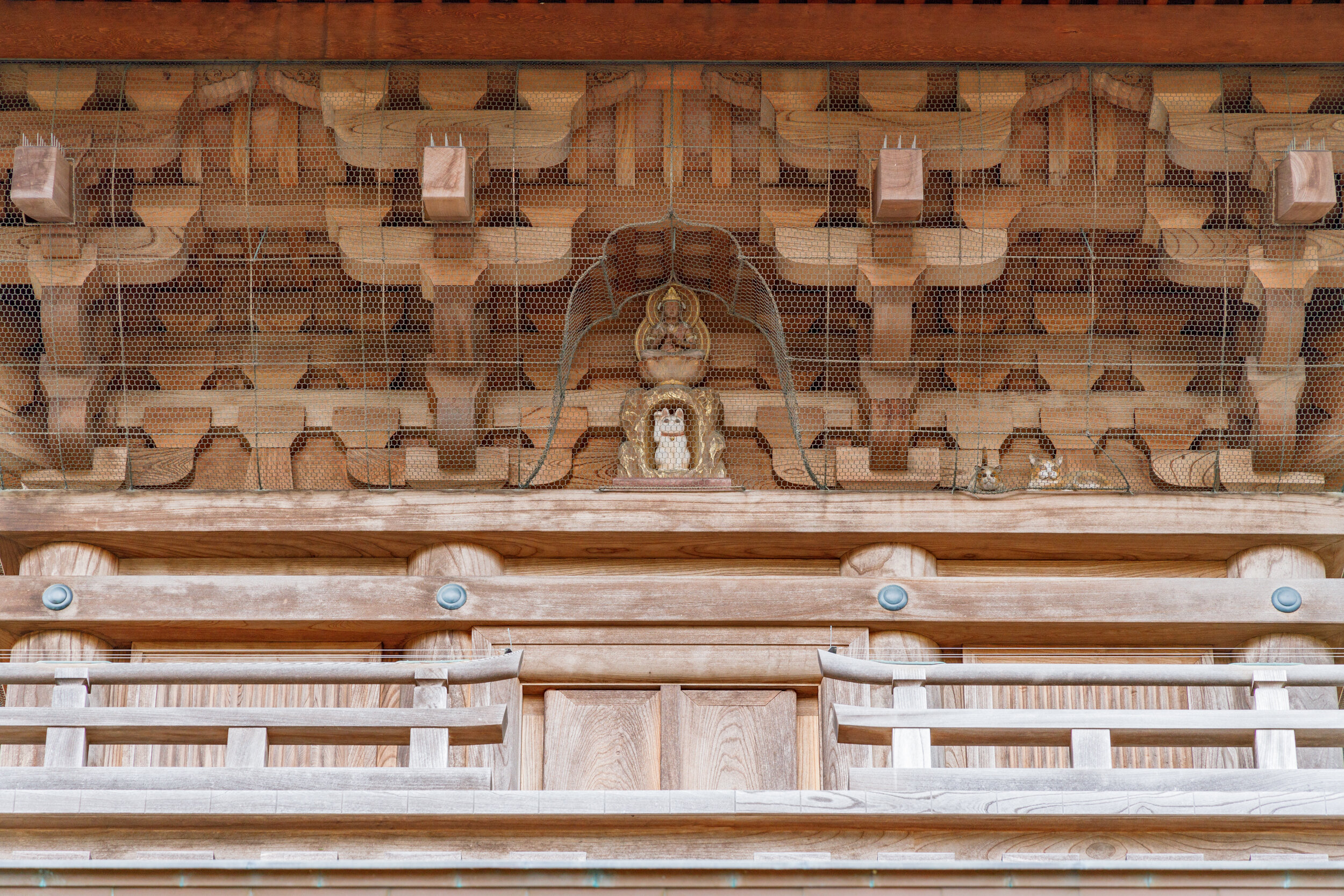Gotokuji Entrance Gate
Beckoning Cat @ Gotokuji
“The Maneki Neko (Japanese: 招き猫, literally "beckoning cat") is a common Japanese figurine (lucky charm, talisman) which is often believed to bring good luck to the owner. In modern times, they are usually made of ceramic or plastic. The figurine depicts a cat (traditionally a calico Japanese Bobtail) beckoning with an upright paw, and is usually displayed in—often at the entrance of—shops, restaurants, pachinko parlors, laundromats, dry cleaners, salons, and other businesses. Modern Japanese superstition suggests that keeping a talisman of good fortune, such as the Maneki Neko, in bedrooms and places of study will bring about favorable results and life successes.”
“ Because of its popularity in Chinese communities (including Chinatowns in the United States) the Maneki Neko is frequently mistaken for being Chinese in origin rather than Japanese, and is incorrectly referred to as a "Chinese lucky cat" or jīnmāo ("golden cat").”
Beckoning Cat Offering Shelves ( before July 2022 Renovation ) and Autumn foliage
Kannon , the goddess of mercy , and Beckoning Cat ( photo taken before July 2022 Renovation )
In Japan , legend has it that the Maneki Neko originated at Gotokuji 豪徳寺 , which is a Buddhist temple located in Tokyo’s Setagaya Ward , and is affiliated with Soto Zen , the largest of the three traditional sects of Zen in Japanese Buddhism . Originated in 1480 , Gotokuji had quite a humble existence until it was designated as one of the official temples for the Ii family in 1633 . In Japan , Buddhist temples have cemeteries in their grounds , and it was quite a honor for Gotokuji to have the tombs of some members of the Ii family , including Ii Naotaka , who served in the Siege of Osaka , and finished building Hikone castle in 1622 . The Ii family were feudal lords in today’s Shiga Prefecture in Japan , serving under the Tokugawa Shogunate , and it’s also worth mentioning that the Ii family had an important role helping the Tokugawa Shogunate establishing it’s power . From Edo , nowadays Tokyo , the Tokugawa Shogunate controlled all of Japan , and in the country side the Daimyo , the feudal lords , serving under the Shogunate , controlled the land . As a way of keeping the Daimyo under it’s control , the Tokugawa Shogunate mandated that the Daimyo should periodically come to Edo to pay their respects . Edo , nowadays Tokyo , flourished during the period of the Tokugawa Shogunate , as it’s capital , though the Emperor resided in Kyoto . In the early Edo period , Gotokuji was still a humble temple , and in it lived it’s chief priest with his pet cat . The temple didn’t have much money , but the chief priest would share his meals with his cat . Legend has it , that once the chief priest asked his cat to bring good fortune . Sometime passed by , and one day , a feudal lord with his entourage entered the temple . The feudal lord was Ii Naotaka . He said that while passing by the temple’s gate he saw the chief priest’s cat waving his paw to him , inviting him to the temple . While a thunderstorm felt outside , Ii Naotaka was served some tea and prayers by the temple’s chief priest . Feeling enlightened and grateful to the temple , Ii Naotaka donated large quantities of rice , quite valuable at the time , thus changing the fortunes of the , at the time , humble temple . Later , Gotokuji was designated as one of the official temples for the Ii family .
Koma Inu atop of Incense Burner and the Tachibana , the Ii Family Crest
Gotokuji is located within 10 minutes walking distance from Gotokuji station on the Odakyu Odawara Line . It’s about a 15 minutes train ride , departing from Odakyu’s Shinjuku station local trains platform ( number 8 or 9 ) .
In 2006 a three storied pagoda was erected . “ In Japanese Buddhist temples , the pagoda’s original purpose was to house relics and sacred writings “ .
Pagoda @ Gotokuji
In this pagoda , the cat themed ornaments are noticeable , and in special , a cat doll on the second floor , which is usually missed by most visitors .
Kannon , above the Maneki Neko and Cat dolls
Cat doll , ornament , @ Gotokuji’s Pagoda
The Pagoda’s entrance faces East , while to the North side the Maneki Prayer Hall is located . The Maneki Prayer Hall underwent renovation and was reopened on July 2022 . Another interesting detail on the Pagoda , are the 12 animals of the Chinese Zodiac represented , 3 on each side , on the ground floor . For your information the 12 animals of the Chinese Zodiac , as in Japanese Culture , are in sequence : the Rat , Ox , Tiger , Rabbit , Dragon , Snake , Horse , Sheep , Monkey , Rooster , Dog and Wild Boar . In a Compass , the Rat would be featured in the North position , while the other 11 animals would be featured in a clock wise formation . Folklore has it that a Chinese Emperor staged a race between the animals to decide which ones were to be featured in the Chinese Zodiac and in which sequence . It is said that the Rat , for being friends with the Ox arrived first , because it jumped to the finishing line after riding on the back of the Ox . Another folk tale is that the Cat was deceived by the Rat , so it is not one of the 12 animals featured on the Chinese Zodiac , but in the Pagoda , the Rat is featured bringing a Koban , a Japanese Coin , to the Maneki Neko . You can see this depiction on the North facet of the Pagoda .
North Side : Ox , Rat and Wild Boar
East Side : Dragon , Rabbit and Tiger
South Side : Sheep , Horse and Snake
West Side : Dog , Rooster and Monkey
On February 24th , 2020 , a Maneki Neko Bronze Statue was unveiled at the entrance to the Maneki Prayer Hall .
Maneki Neko Bronze Statue
On July 2022 the reform of the Maneki Prayer Hall was finished . The difference between this Prayer Hall and the other Prayer Halls at the Gotokuji Temple grounds is that the deity enthroned at the altar is the Beckoning Cat . It’s possible to take a look through the glass on the doors of the Prayer Hall .
Maneki Prayer Hall Entrance
Renewed Manki Prayer Hall
There are Offering Shelves to the left of the Maneki Prayer Hall and at the back side . The new Offering Shelves at the left of the Maneki Prayer Hall now feature roofs over them .
Beckoning Cat Offering Shelves as of July 2022 .
Another recent addition to the temple was the Jizo Hall , that is located at the right side from the main gate . The Jizo statues already existed , but until recently there wasn’t a place reserved for public display .
There’s one saying that the Devil only walk through straight paths so it’s common to see in Japanese Gardens and other pathways, a broken pattern , a not straight path . You can observe this pattern at the entrance path to the Jizo Hall . Another interesting detail can be observed in the Votive Lanterns ( 献燈 ) at the entrance . You can clearly see the Ii family’s Kamon ( Family Crest ) , the Tachibana ( a type of Japanese Orange ) . The Ii Family Crest is also featured at the top of the temple’s main gate and the in the incense burner .
Quote from this Wikipedia article : “Kṣitigarbha is known for his vow to take responsibility for the instruction of all beings in the six worlds between the death of Gautama Buddha and the rise of Maitreya, as well as his vow not to achieve Buddhahood until all hells are emptied. He is therefore often regarded as the bodhisattva of hell-beings, as well as the guardian of children and patron deity of deceased children and aborted fetuses in Japanese culture, where he is known as Jizō or Ojizō-sama”
The Jizo statue at the back of the Jizo Hall is believed to have been built around the beginning of the Edo Period ( 1603 AD ). There are records that this statue underwent a restoration process in 1794 AD . This Jizo statue underwent another restoration process from April 2021 until March 2023 .
Gotokuji Jizo Hall
Jizo Statues @ Gotoku-ji Jizo Hall as of November 2020
The Tachibana - Ii Family Crest
Jizo statue after restoration as of November 2024
Some facts about Maneki Neko . Maneki Neko with their right paw standing are said to bring good fortune , while the ones with the left paw standing are said to bring in customers . Common colors for Maneki Neko are white , black and gold , sometimes red . Usually Maneki Neko feature a 小判 ( Koban coin ) , but the ones found at Gotokuji don’t have it . The explanation given at the temple’s homepage is that 招福猫児 Maneki Neko can help with your 縁 En ( Fate , Karma or Destiny ) , but it will depend on the person’s attitude to achieve 福 ( Good Fortune ) .
The Maneki Neko statues placed at Gotokuji temple are bought at the temple’s office and are offerings from people who visit it . The temple’s staff kindly ask visitors not to write on the back of the Maneki Neko statues , and instead to write the wishes in Ema , votive tablets that can be bought at the temple’s office , and place it at the designated places at the temple . The temple’s staff encourage visitors to take the Maneki Neko statues to their homes as amulets .
This Blog post contains “citations” from Wikipedia , information from written Wikipedia articles , and information found at the temple’s homepage .
※This Blog post was updated on November 25th , 2024 .





















